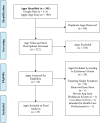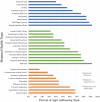Comprehensively addressing postpartum maternal health: a content and image review of commercially available mobile health apps
- PMID: 33879089
- PMCID: PMC8059182
- DOI: 10.1186/s12884-021-03785-7
Comprehensively addressing postpartum maternal health: a content and image review of commercially available mobile health apps
Abstract
Background: The United States is currently facing a maternal morbidity and mortality crisis, with the highest rates of any resource-rich nation. In efforts to address this, new guidelines for postpartum care suggest that mobile health (mHealth) apps can help provide complementary clinical support for new mothers during the postpartum period. However, to date no study has evaluated the quality of existing mHealth tools targeted to this time period in terms of sufficiency of maternal health information, inclusivity of people of color, and app usability.
Methods: Preferred Reporting Items for Systematic Reviews and Meta-Analyses (PRISMA) standards were used to review the peripartum apps from the Apple and Google Play stores in either the Health/Fitness, Medical, or Education categories. Apps were evaluated for extent and quality of maternal health information and inclusivity of people of color using an a priori coding scheme. App usability was evaluated using the Mobile Application Rating Scale (MARS) score.
Results: Of the 301 apps from the Apple and Google Play stores, 25 met criteria for final evaluation. Of the 30 maternal health topics coded for, the median number addressed by apps was 19.5 (65%). Peripartum behaviors were more frequently addressed than peripartum outpatient care topics and peripartum acute health risks. The coverage of maternal health information and inclusivity of people of color in app imagery both correlated positively with the MARS usability score of the app. Only 8 apps (32%) portrayed greater than 24% images of people of color- the percent of non-white Americans according to 2019 census estimates. There was no correlation between MARS usability score and number of app users, as estimated by number of ratings for the app available on the app store. In addition, apps with evidence-based maternal health information had greater MARS engagement, information, and aesthetics scores. However, presence of evidence-based information did not correlate with greater numbers of app users.
Conclusions: Current commercially available peripartum apps range widely in quality. Overall current app offerings generally do not provide adequate maternal health information and are not optimally accessible to the target users in terms of inclusivity of women of color or app usability. Apps delivering evidence-based information and more usable design are more likely to meet these standards but are not more likely to be downloaded by users.
Keywords: Digital health; Health disparity; Health education; Maternal health; Maternal morbidity; Mobile apps; Mobile health; Peripartum; Postpartum; Pregnancy; mHealth.
Conflict of interest statement
TK is a co-founder of Naima Health LLC, which develops digital health tools to engage patients in clinical care.
Figures



Similar articles
-
Popular Evidence-Based Commercial Mental Health Apps: Analysis of Engagement, Functionality, Aesthetics, and Information Quality.JMIR Mhealth Uhealth. 2021 Jul 14;9(7):e29689. doi: 10.2196/29689. JMIR Mhealth Uhealth. 2021. PMID: 34259639 Free PMC article.
-
Mobile Apps for Common Noncommunicable Disease Management: Systematic Search in App Stores and Evaluation Using the Mobile App Rating Scale.JMIR Mhealth Uhealth. 2024 Mar 12;12:e49055. doi: 10.2196/49055. JMIR Mhealth Uhealth. 2024. PMID: 38532298 Free PMC article.
-
Quality of Mobile Apps for Care Partners of People With Alzheimer Disease and Related Dementias: Mobile App Rating Scale Evaluation.JMIR Mhealth Uhealth. 2022 Mar 29;10(3):e33863. doi: 10.2196/33863. JMIR Mhealth Uhealth. 2022. PMID: 35348467 Free PMC article.
-
Exploring Heart Disease-Related mHealth Apps in India: Systematic Search in App Stores and Metadata Analysis.J Med Internet Res. 2025 Mar 10;27:e53823. doi: 10.2196/53823. J Med Internet Res. 2025. PMID: 40063078 Free PMC article.
-
Evaluation of Mobile Apps Targeted to Parents of Infants in the Neonatal Intensive Care Unit: Systematic App Review.JMIR Mhealth Uhealth. 2019 Apr 15;7(4):e11620. doi: 10.2196/11620. JMIR Mhealth Uhealth. 2019. PMID: 30985282 Free PMC article.
Cited by
-
Features, Design, and Adherence to Evidence-Based Behavioral Parenting Principles in Commercial mHealth Parenting Apps: Systematic Review.JMIR Pediatr Parent. 2023 Jun 1;6:e43626. doi: 10.2196/43626. JMIR Pediatr Parent. 2023. PMID: 37261886 Free PMC article.
-
Using mHealth to reduce disparities in Black maternal health: Perspectives from Black rural postpartum mothers.Womens Health (Lond). 2024 Jan-Dec;20:17455057241239769. doi: 10.1177/17455057241239769. Womens Health (Lond). 2024. PMID: 38773870 Free PMC article.
-
Technology-Based Approaches for Supporting Perinatal Mental Health.Curr Psychiatry Rep. 2022 Sep;24(9):419-429. doi: 10.1007/s11920-022-01349-w. Epub 2022 Jul 23. Curr Psychiatry Rep. 2022. PMID: 35870062 Free PMC article. Review.
-
Reducing Maternal Mortality Rates in Alabama Through Patient Education: A Scoping Review.Cureus. 2023 Aug 8;15(8):e43172. doi: 10.7759/cureus.43172. eCollection 2023 Aug. Cureus. 2023. PMID: 37692638 Free PMC article.
-
Evaluation scale and behavioral model construction for intention to use postpartum exercise rehabilitation mobile application based on user experience.Front Psychol. 2025 May 30;16:1575049. doi: 10.3389/fpsyg.2025.1575049. eCollection 2025. Front Psychol. 2025. PMID: 40519838 Free PMC article.
References
-
- Hoyert DL, Uddin SF, Miniño AM. Evaluation of the pregnancy status checkbox on the identification of maternal deaths. 2020. - PubMed
Publication types
MeSH terms
Grants and funding
LinkOut - more resources
Full Text Sources
Other Literature Sources
Medical
Miscellaneous

